How to ID and manage pests with IPM
Insects and insect-like creatures found inside our homes are usually quite harmless. Most often, they can be trapped and moved outside easily if need be and if someone is able to do so. Even so, there are some insects or insect-like pests entering the home that are potentially harmful to humans and pets. Whether they inflict sanitation issues, painful bites or stings, are a nuisance, or induce fear, there are many home pests that we do need to manage and safely remove.
Still, none of this calls for busting out the toxic bug balms. Here's how you can manage pests more sustainably through IPM:
Prevention
Preventing insect and insect-like pests from entering your indoor spaces is the first step in an IPM strategy.
Know what they like
Determine the type of hiding spots—locations in the home and perimeter areas along the home—that the pests are living in and/or frequenting.
Detection
Spend some time looking around your home. Check spaces by windows and doors, crevices and cracks, trash/recycling/compost zones, pantry, food storage and dining areas, as well as places where moisture, dirt, dust, or debris has accumulated. Plus, make sure to triple-check anywhere you’ve previously noticed a pest. Psst! This is a great activity to do while cleaning to prevent pests in the first place!
Correct ID
Identify the insect (or insect-like creature) using vetted identification resources so you know what you’re up against. Some of our favorites:
- iNaturalist or Seek (great app for kids to learn about the natural world!)
- Picture Insect
- Cornell’s What’s Bugging You Guide
- Scroll for more ID info right here!
Learn more
Find out all you need to know about the pest to make sure you’re able to manage and eradicate it effectively. Use our guide below or check out the following resources:
Monitor
Track pest activity and treatment.
Control first by following IPM and prevention information. Then, make adjustments to cleaning and sanitation management in the home—and only rely on chemicals as a last-resort.
Monitor the areas where you are managing insect and insect-like pests and track changes (pest presence) over time.
Most common indoor insects and insect-like pests
Need help with IDing your pest? Below are the most common pests Sunday customers encounter in their home, information on how to prevent these pests, ways you can manage them, and which Sunday pest control products can effectively treat them if needed! Some of these pests even have their own personal pest profile to dive a little deeper into how to prevent and manage them.
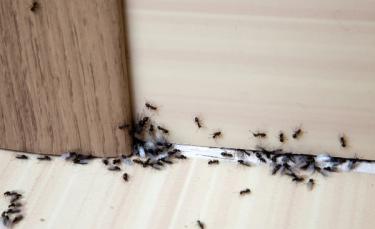
Ants
Most common: Odorous house ants (Tapinoma sessile)
Quick ID:
- Less than 1/10 of an inch
- Dull brown color
- Funky blue cheese smell when crushed
- No obvious node on the waist
Where are they found
Nationwide, both indoors and outdoors
Type of damage
In landscape and house perimeter, nuisance ant that will form trails inside the home
Prevention
Remove landscape features like borders, that encourage nests (wood, rocks, slate).
Removal
This ant is difficult to manage even with pesticides. The best way to eliminate colonies is to use baits that are brought back to the nest and shared. Liquid insecticide applications may kill foraging ants, but may not have a measurable impact on the colony.
Recommended Sunday product:
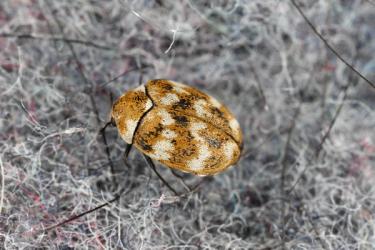
Beetles
Most common: Variegated carpet beetle (Anthrenus verbasci), Black carpet beetle (Attagenus brunneus)
Quick ID
- Around 1/10 of an inch (most common)
- Small, oval-shaped insect
- Two sets of wings
- Clubbed antennae
Where are they found
Throughout the United States
Type of damage
Fabric pest that can feed on natural or animal-based fibers as larvae (adults feed on pollen). Can damage wool, cashmere, etc, but larvae can also feed on animal dander (dog fur collecting in corners).
Prevention
- A thorough inspection of the household, including any carpet, furnishings, and clothing.
- In pet areas, look for larvae, cast skins, and damage.
Removal
Vacuuming, steam cleaning, and dry cleaning will help remove and kill carpet beetles. Cold storage treatment—placing things outside when temperatures are below freezing, or placing small items in a freezer—can also sometimes help.
Recommended Sunday product:
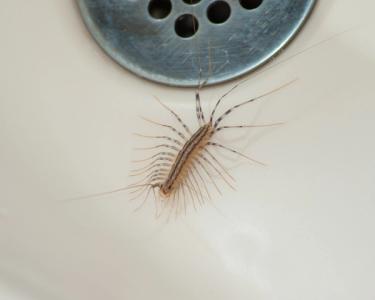
House Centipede
Scutigera coleoptrata
Quick ID
- Up to 1.5 inches long
- Up to 15 pairs of legs
- Tan with brown markings
- Long feathery legs that move fast
Where are they found
Nationwide. Usually found in basements or cool damp places. Sometimes get trapped in bathtubs, but this is often from finding access into bathrooms through cracks and crevices, entering the tub, and not being able to get out.
Type of damage
Considered harmless and can be a beneficial predator—mostly a nuisance. Enter structures from gaps at the foundation level. Mulch beds are attractive to other arthropods, which house centipedes eat.
Prevention
- Exclude house centipedes and other crawling arthropods by closing gaps in the foundation and ground-level doors and openings.
- Reduce humidity of basement, ground floor.
Removal
Trapping and moving the pest outdoors is the best way to remove the pest from indoor settings. A clear cup and piece of paper can usually do the trick!
Recommended Sunday product:
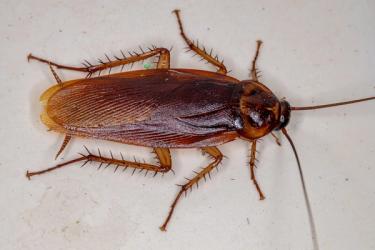
American Cockroach
American cockroach (Periplaneta americana)
- 1.25-2.25 inches
- Rusty brown color
- Flat body, long antennae, wings cover the body
- Pair of cerci (little sensory projections) poke out from under the wings toward the rear of the abdomen
Where are they found
Nationwide. Are common outdoors along the perimeter of the house in the southeast and south central. Elsewhere, they’re more common indoors, particularly in the kitchen, bathroom, and basement.
Type of damage
Sanitation pests that feed on food spillage and organic waste—including feces, which is why they are associated with broken sewer lines. Possible mechanical vector of pathogens (meaning they can transfer pathogens from one location to another on their bodies).
Prevention
- Can enter buildings from the perimeter or through pipes or gaps around pipes.
- Identify the source!
- If outside, look in landscapes, sewers, lower and underground parts of buildings.
- If inside, check wet areas, basements, crawl spaces, and outer walls.
- Finding nymphs and egg cases indicates proximity to the breeding source; adults (with wings) can travel far.
- Remove alternative food sources, seal harborages (areas where cockroaches can seek shelter), repair damage to pipes, etc.
Removal
If a hiding site is found, a direct application of Sunday’s Bug Doom can reduce the number of cockroaches. Otherwise, baits are preferred to kill cockroaches via trophallaxis—meaning they collect the bait and then share it within the entire colony.
Recommended Sunday product:
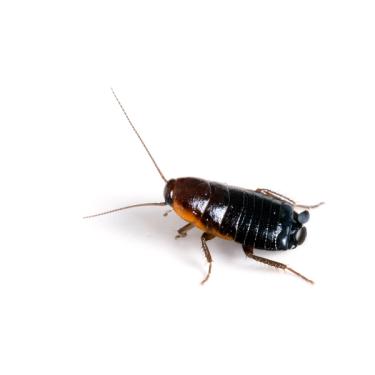
Oriental Cockroach
Quick ID
- About 1 inch in size
- Long and dark brown to black, shiny
- Males have short wings, females have very short wings
- Long antennae
- Distinct cerci, or paired appendages on the rear
Where are they found
Nationwide. Found mainly around structure perimeters and areas with moisture and sanitation issues (basements, bathrooms, drains, sewers, and landscapes). Has become naturalized as far north as NY, which means it lives outdoors and overwinters.
Type of damage
Sanitation pest that feeds on food spillage and organic waste—including feces, which is why they are associated with broken sewer lines. Possible mechanical vector of pathogens.
Prevention
- Can enter buildings from the perimeter or through pipes.
- Prevent them from entering the structure with door sweeps or weather stripping.
- Monitor with sticky traps indoors.
- Remove food/water sources and reduce moisture.
- Reduce hiding spots (cardboard, bags, piles of plant debris, clutter).
- Trim shrubs or remove ground covers from the perimeter of the building to reduce hiding spots.
Removal
Perimeter treatment of building and landscape will help to eradicate the pest outdoors.
Recommended Sunday product:
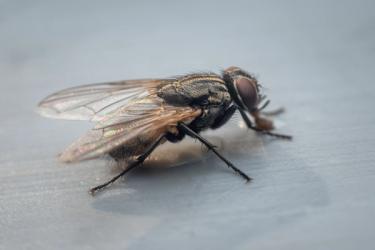
House flies
Quick ID
- Adults are ⅕ inch long
- Four longitudinal stripes on their thorax (body segment behind the head)
- Abdomen (last segment) is variable in color, from yellowish to gray
Where are they found
Nationwide. Outdoors, flies are common where food is prepared and consumed, areas of poor sanitation, or around feces. Indoors, can be found where food is prepared and consumed if windows and doors are left open.
Type of damage
House flies are a nuisance pest and potential mechanical vectors of human pathogens. This is because they can feed on things like pet feces and decaying garbage and then transfer pathogens to food items and to food preparation surfaces.
Prevention
- Window screens and keeping doors closed is the best way to prevent indoor problems with flies.
- Insect light traps are used indoors to intercept flies that may be pulled in, and fly tape is available too for locations where food is not prepared.
- The most important prevention step is source reduction: Eliminate decaying organic vegetation such as piles of grass clippings, wet garbage left out for more than a week, piles of pet feces, etc. These are all breeding sources for flies, which can reproduce rapidly in warm months.
Removal
Flies can be spot treated to kill them, but the same effect can be achieved with the use of a fly swatter.
Recommended Sunday Product:
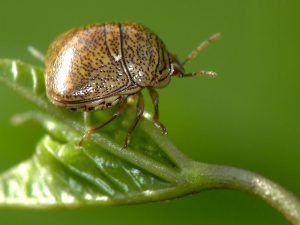
Kudzu bug
Megacopta cribraria
Quick ID
- Adults are ¼ inch long
- Aounded/oblong shape and squat stature, but appear nearly square-shaped
- Mottled brown color with red eyes
Where are they found
Southeast region of US. Enters buildings through windows, doors, vents, etc.
Type of damage
This is an invasive insect that was accidentally introduced to Georgia. It feeds on invasive kudzu, but also feeds on soybeans. Around structures, they congregate on buildings in large numbers and can enter homes. They are an overwintering pest similar to brown marmorated stink bugs, multicolored Asian lady beetles, and other related bugs.
Prevention
- Exclusion to seal gaps around windows, doors, foundation, soffits, etc.
- Prevention should be completed in the summer before fall invasion and after overwintering pests have left structures in the spring.
Removal
Treat cracks and crevices where bugs may enter. This should be done as close to when pests will enter homes as possible to ensure that products are at the most active.
Recommended Sunday Product:
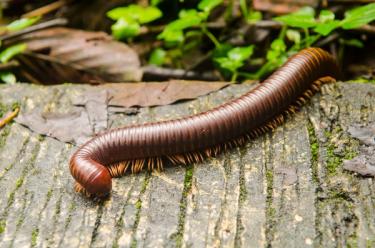
Millipede
Order Julida
Quick ID
- Variable, but commonly 1 inch
- Long shiny, segmented, dark brown body
- Slow mover and curls into a circle when disturbed
Where are they found
Nationwide, mainly in the basement or ground-level entry areas.
Type of damage
Nuisance, occasionally in high numbers. These arthropods are detritivores that feed on decaying organic material. Their populations can get large over time and they may invade structures in large numbers in some cases.
Prevention
Seal cracks and other openings to the home to prevent entry.
Removal
Pest exclusion at the foundation level can help reduce problems with these pests.
Recommended Sunday product:
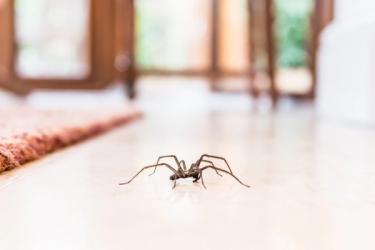
Spider
Many species
Note: Of greatest concern are the venomous spiders, including black widows, hobo, and brown recluse spiders and defensive spiders, like wolf spiders.
Quick ID
- Eight legs
- Two body parts (cephalothorax and abdomen)
- No more than 3 inch leg span (fishing and wolf spiders have 1 inch long bodies)
Where are they found
Nationwide. Usually found on the first floor, basement, and perimeter. If outdoors, usually found in landscaping.
Type of damage
Potential for bites, especially with wolf and black widow spiders, but generally an aesthetic pest that causes fear.
Prevention
- Vacuuming or sweeping behind, above, and under isolated spaces tends to deter spiders.
- Reduce clutter and food sources for other insects that act as food for spiders.
- Reduce moisture in the perimeter landscape to reduce all arthropod activity.
- Simplify perimeter landscape to reduce hiding spaces.
Removal
In the case of gathering spiders and their hatching eggs, a vacuum cleaner with a bag is the best defense. Vacuum and immediately move vacuum outside, remove bag into a trash bag, close, and dispose of promptly.
Recommended Sunday product:
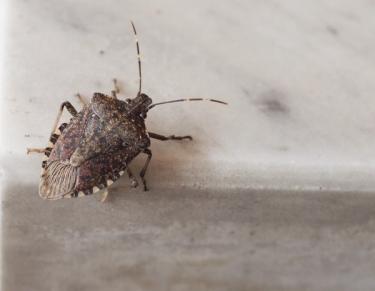
Brown marmorated stink bug
Halyomorpha halys
Quick ID
- About ½ inch shield shape
- Brown/grey mottled color, striped edges
- 2 light-colored bands of the antennae
- Rounded shoulders
- Alternating black and white coloration on the margins of the abdomen
Where are they found
Invasive species found in almost every US state. Common in attics, wall interiors, and inside the home. Also a common overwintering pest.
Type of damage
Agricultural pest that can damage fruit trees growing around the home or in orchards. They are considered a structural nuisance because they enter in large numbers in fall—through cracks and crevices around windows, doors, and other areas. They are active throughout the winter on warm days and emerge in spring. They do not reproduce indoors, feed on anything indoors, or create nests; they simply enter buildings and wait for warm weather.
Prevention
- Seal gaps around windows and doors.
- Use porous materials to seal window weep holes, which will prevent insect entry but allow water to drain from the window.
- Repair damaged window screens and remove or cover and seal window air conditioning units.
Removal
If stink bugs enter the home, insecticide applications are ineffective.
Recommended Sunday product:
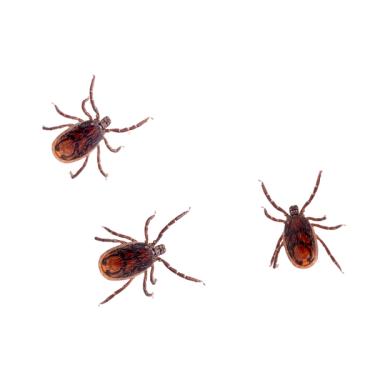
Brown Dog Tick (Rhipicephalus sanguineu)
Quick ID
- Less than ⅛ inch long
- Nymphs and adults have eight legs; larvae have six legs
- Dark brown with no special markings
- Teardrop shape, with short mouthparts
Where are they found
Nationwide, but most common in the Southeast. Found outdoors and indoors, especially near pet resting areas.
Type of damage
Ticks can bite people and pets. Brown dog ticks are vectors of canine ehrlichiosis and babesiosis and Rocky Mountain spotted fever.
Prevention
- Accurate identification of tick species is essential to understand biology, breeding requirements, and the location of the infestation.
Tick Checks 101
- First, check your clothing and outdoor gear! Ticks hide in folded areas, near belt loops, and around your boots and socks.
- Check your entire body for ticks. We recommend checking all the joint regions (knees, elbows, armpits) and all areas near your hairline. Ticks love these spots!
- You’re probably dirty from spending all that time outside right? A good way to thoroughly tick check is to just take a shower and check yourself head to toe. Plus, ticks really give us that creepy crawly feeling anyways, don’t they?
- Finally, make sure to check and remove ticks from your furry friends after spending time outside. Bonus tip? Use tick and flea collars or vet recommended topical applications to prevent ticks to begin with!
Sunday Tip:
If you find ticks on clothing, you can tumble dry gear and clothing for 10-15 minutes on high heat to kill the ticks.
Removal
Crack and crevice treatment where ticks are found and where pets sleep using an appropriately labeled product.
Recommended Sunday product:
Cited Sources
Cornell CALS. New York State Integrated Pest Management.
Cornell University UC IPM. What Is Integrated Pest Management?.
UCANR. Penn State Extension. Integrated Pest Management (IPM) Tactics.
Penn State University. Frank, S. et al. Integrated Pest Management (IPM).
NC State Extension. Windbiel-Rojas, K. Centipedes and Millipedes. UC IPM.







